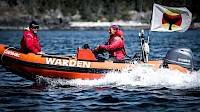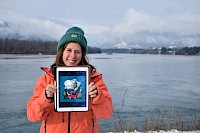BC Parks Foundation
5 Ways to be an Armchair Naturalist
April 13, 2020
Photo: Black-capped chickadee in Myra Bellevue Provincial Park by Jason Headley, BC Parks iNaturalist Project
For much of the past year we’ve been encouraging you to use iNaturalist to record your animal, plant, fungi, and “what-is-that?!” observations when exploring our beautiful parks. By doing so you have helped the BC Parks iNaturalist Project celebrate and document the incredible biodiversity in our province, all the while learning about the species around you and creating an interactive record of your outdoor explorations. The project’s 2019 roving summer bioblitz field crew and over 2,500 other nature enthusiasts collected more than 100,000 floral, faunal, and fungal observations, providing us with an abundance of amazing biodiversity finds from across the province.
 Photo: Prickly Saxifrage (Saxifraga tricuspidata) in Stone Mountain Provincial Park by Jason Headley, BC Parks iNaturalist Project
Photo: Prickly Saxifrage (Saxifraga tricuspidata) in Stone Mountain Provincial Park by Jason Headley, BC Parks iNaturalist Project
While we wish we could encourage you to get out into B.C.’s parks and collect as many observations as you can once again this spring and summer, parks have been closed to keep visitors, staff, and parks themselves safe and healthy during the COVID-19 pandemic (as of April 8th all parks are fully closed until further notice and camping has been suspended until May 31 — check the BC Parks website for updates).
But good news! You can still put your curiosity, photos, and knowledge to good use with this project, all from the comfort of your couch (or kitchen table, bed, home office — wherever you and your computer are working from these days).
Here are five ways to be an Armchair Naturalist:
 Photo: American red squirrel in Kokanee Provincial Park by Robby Deans, BC Parks iNaturalist Project
Photo: American red squirrel in Kokanee Provincial Park by Robby Deans, BC Parks iNaturalist Project
1. Exercise your curiosity
Check out the BC Parks iNaturalist Project page to browse species observations made in the parks so far. Find your favourite park on the project leaderboard to learn which species call it home. Send us the coolest creatures you come across!
2. Share your knowledge
Do you have an affinity for amphibians? A mind for molluscs? Identify observations to help others learn more about their nature finds! This helps others improve their ID skills and it makes the project’s data more accurate.
3. Take a trip down memory lane
You likely have an abundance of nature photos languishing on your hard drive, unseen by anyone but you. Reminisce about past trips while adding those photos to iNaturalist! There is no age cut-off for observations, and historic data provide valuable context. This nature enthusiast has even scanned decades worth of photographic slides.
4. Go for bingo
Download the BC Parks Foundation's themed PARKS bingo cards and scour your photo library for matching observations. When you get bingo, send us a photo of your completed card and matching observations!
5. Hone your skills
If you're lucky enough to have a backyard or to live in a more remote place where it's easy and safe to get out into nature (remember to maintain at least a 2 metres/6 feet away from others), go practice your iNaturalist skills so you’re ready to go when parks re-open. Add your efforts to iNaturalist Canada’s Observations from Isolation project, or join the 5 Mile Radius Canadian Challenge. Be sure to note cultivated plants as such when adding observations!
 Photo: Purple urchin in Juan de Fuca Provincial Park by Geneviève Reynolds, BC Parks iNaturalist Project
Photo: Purple urchin in Juan de Fuca Provincial Park by Geneviève Reynolds, BC Parks iNaturalist Project
New to iNaturalist? Here are some resources to get started:
- Download the BC Parks Foundation’s How-To Guide
- Watch this Citizen Science Tools Webinar, hosted by the Howe Sound Biosphere Reserve Initiative
- Check out iNaturalist's very comprehensive help menu.
And finally, subscribe to the BC Parks Foundation's newsletter to stay up-to-date with any news or changes regarding this project and other Foundation work.
Happy armchair iNatting!
About the author
Kelly Fretwell works on science communication, iNaturalist, and biodiversity topics for the Hakai Institute. Her love of coastal ecology comes in part from growing up exploring shorelines and forests near Victoria BC, as well as from her post-secondary education in biology, environmental studies and marine management. Kelly lives in Victoria, where she enjoys spending time in nearby natural spaces and forcing friends to stop on hikes so she can take photos and try to identify things.
Love this? For more inspiring stories about conservation wins, community efforts, and ways you can help protect nature, subscribe to our newsletter today.
Similar Stories
-
 August 23, 2024
August 23, 2024
Important Biodiversity and Land Protected in Smuggler Cove and Jeddah Point
-
 November 15, 2018
November 15, 2018
Keeping the Magic Alive at Robson Bight Ecological Reserve
-
 November 26, 2024
November 26, 2024
Wild Is Cool: The Art of Turbo Bambi
“In every walk with nature, one receives far more than they seek.
”